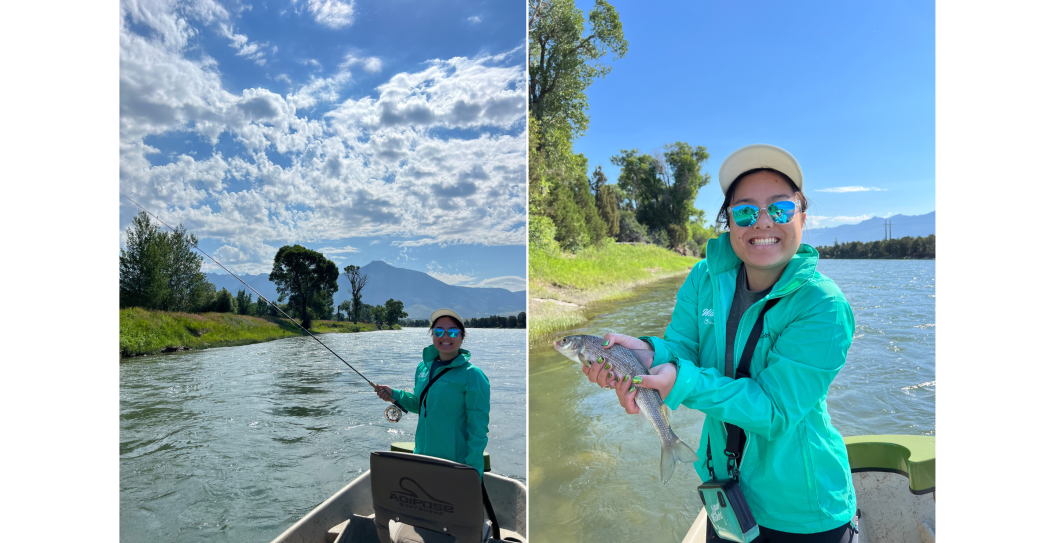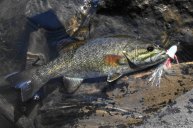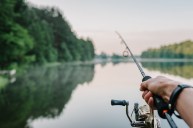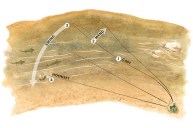I've been fishing with my dad since I was in high school. We'd catch all kinds of fish: sea bass, flounder, porgy—you name it. I thought I knew everything there was to fishing—until I went on my first fly fishing trip in Montana.
From casting to setting the hook, I quickly learned that fly fishing bore little resemblance to my prior experiences fishing. Compared with conventional fishing—which requires a wide range of baits (worms, scallops, baitfish and the like)—fly fishing relies on flies crafted from feathers, fur, and other materials that mimic aquatic insects and much of the same prey we use in live-bait fishing.
Another notable difference is the casting technique. In fly fishing, anglers use a back-and-forth motion called the "fly cast." This allows the angler to use the weight of the fly line to cast instead of the weight of the fly, which is relatively light compared with conventional fishing lures.
In the world of conventional fishing, I had grown accustomed to finding my footing on a charter boat, dangling my pole over the railing, and patiently awaiting the telltale signs of movement in my rod. Fly fishing wasn't that. I only just started to learn its many techniques and approaches—but the learning was fun.
Here are my major takeaways on how fly fishing differs from conventional fishing, based on my first-day experiences.
1. Fly Fishing Emphasizes Visual Cues
The tactile sensitivity that I had relied upon so heavily during conventional fishing seemed no longer viable. Instead, I found myself refining my focus on visual clues and fixating on the movement of the bobber (in fly fishing, often called an "indicator") on the water's surface.
"Trout are extremely wary fish" and fast, too, one licensed Gallatin River fishing guide told me. Even the slightest movement or noise would send the fish running for the hills. Given their agile nature, trout possessed the ability to snatch the baited hook and make a dart for it before I could react. Their speediness made it extremely difficult to have successful hooksets and bring the fish to net.
After hours of trial and error on the Gallatin River, I had finally prevailed and caught a small trout. I attribute this catch to being able to hook-set quickly and without hesitation. To say the least, setting up the hookset was a learning curve.
2. Fly Rods Are Lighter—and Different
Another major difference between conventional and fly fishing is the poles. Compared with conventional rods, fly fishing rods are slimmer and whippier, and therefore lighter to carry around. Additionally, fly rods require a different grip than I was accustomed to; they involve "shaking hands" with the rod and placing my thumb on the top of the cork grip and my fingers wrapped around the bottom.
Line control with this grip is different in fly fishing as well: Most techniques involve leaving a small loop of slack line between the reel and the first rod guide. This extra line is managed with the left hand and helps with casting and controlling the line on the water (called "mending"). As I wasn't used to extra slack, this was difficult.
3. Casting Takes Time to Learn
I am used to hanging my rod over the boat railing and sending my line straight down. With fly fishing, I had to cast over my head, stop for a brief second at the 1 o'clock position, forward cast the line, and allow the line to drift with the current.
Timing is crucial in a fly fishing cast. If my motion was not crisp or controlled, my line would get tangled, reach a shorter distance, or create ripples that disturbed the natural presentation of the fly—which would send trout scattering. Fly casting takes years to perfect; but after only a day, I was feeling some improvement. Learning basic techniques like the roll cast, I could tell, would be a big upgrade to my skill set.
4. When Wading, Balance Is Key
Sure, you can fish along the bank; but in fly fishing, there are many spots that require getting into the river. The water my guide called "trout rich" was often right in the middle of the river. This required solid wading skills. The Gallatin River's current was strong, and I found myself slipping. While beginners can certainly get away with just the essential fly fishing gear, a good pair of waders and boots would be necessary if you want to be safe and effective while working the river.
While fly fishing was undoubtedly challenging, I found my confidence growing with each catch and successful hookset. The intricacies of the technique made it tougher than conventional fishing on day 1. But fly fishing for the first time taught me more about myself and the sport, and I look forward to my next outing.
READ MORE: How to Put Together the Perfect Fly-Fishing Tackle Box




